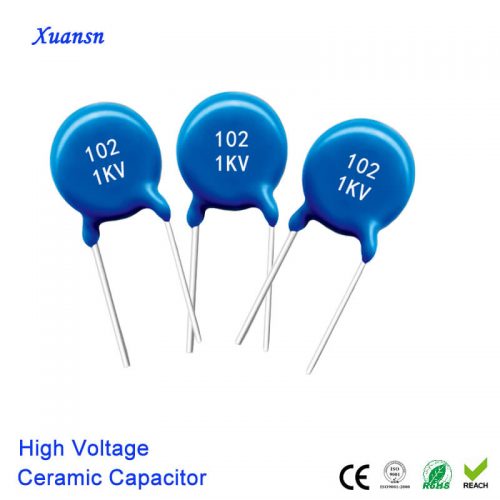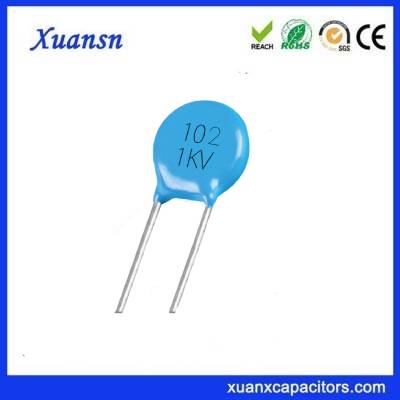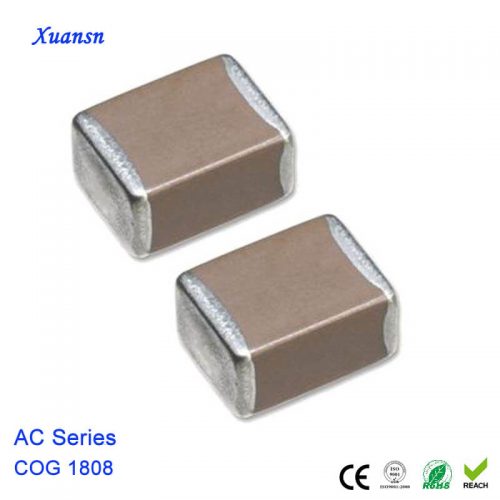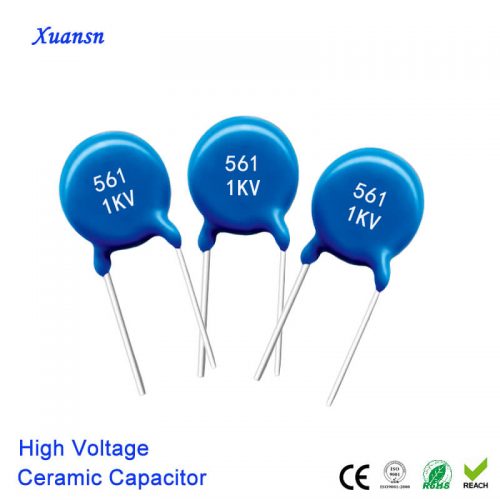- Power supply decoupling
- Signal coupling and filtering
- Timing circuits
- Snubber circuits
- Audio amplifiers
- XUANSN Manufacturer
100nF Capacitor 0.1uF 104J High Frequency Multilayer Ceramic
Description
Overview:
A multilayer ceramic capacitor (MLCC),0.1uF/104/100nF Capacitor,is an electronic component that is commonly used for its capacitance properties in a wide range of electronic circuits and devices. It is constructed using multiple layers of ceramic material, typically made of ceramic dielectric materials such as barium titanate or titanium dioxide.
First let us understand the meaning of this 104 code.
| Capacitance Value | Capacitance (uF) | EIA-96 Code | EIA-600 Code |
|---|---|---|---|
| 1PF | 0.000001uF | 01 | 010 |
| 2.2PF | 0.0000022uF | 02 | 022 |
| 4.7PF | 0.0000047uF | 03 | 047 |
| 10PF | 0.00001uF | 04 | 100 |
| 22pF | 0.000022uF | 05 | 220 |
| 47pF | 0.000047uF | 06 | 470 |
| 100pF | 0.0001uF | 07 | 101 |
| 220pF | 0.00022uF | 08 | 221 |
| 470pF | 0.00047uF | 09 | 471 |
| 1nF | 0.001uF | 10 | 102 |
| 2.2nF | 0.0022uF | 11 | 222 |
| 4.7nF | 0.0047uF | 12 | 472 |
| 10nF | 0.01uF | 13 | 103 |
| 22nF | 0.022uF | 14 | 223 |
| 47nF | 0.047uF | 15 | 473 |
| 100nF | 0.1uF | 16 | 104 |
| 220nF | 0.22uF | 17 | 224 |
| 470nF | 0.47uF | 18 | 474 |
| 1uF | 1uF | 19 | 105 |
| 2.2uF | 2.2uF | 20 | 225 |
| 4.7uF | 4.7uF | 21 | 475 |
| 10uF | 10uF | 22 | 106 |
| 22uF | 22uF | 23 | 226 |
| 47uF | 47uF | 24 | 476 |
| 100uF | 100uF | 25 | 107 |
| 220uF | 220uF | 26 | 227 |
Please note that the EIA-96 code system is commonly used in the United States, while the EIA-600 code system is often used in metric regions. These codes represent the significant figures and the number of zeros to be added after them to denote the capacitance value.
Keep in mind that this table includes some common values, but there are many other capacitance values available beyond those listed. The codes provided here should help you identify and select the appropriate capacitor values based on the code printed on the component or specified in a datasheet.
Multilayer Ceramic 100nF Capacitor Structure
Multilayer ceramic 100nF capacitor are widely used electronic components that consist of alternating layers of ceramic dielectric material and metal electrodes. The specific structure of MLCCs can be described as follows:
- Ceramic Dielectric Material: The ceramic dielectric material is the main component of the MLCC. It is typically made of ceramic materials such as barium titanate (BaTiO3), which exhibits excellent dielectric properties. The dielectric material is formulated and processed to achieve the desired capacitance and other electrical characteristics.
- Metal Electrodes: MLCCs have metal electrodes that are alternately stacked with the ceramic layers. The most commonly used electrode materials are silver (Ag) and palladium silver (Pd/Ag). The electrodes are usually applied to the ceramic layers through a screen printing process.
- Inner Electrode Configuration: MLCCs have different inner electrode configurations, which determine their capacitance values and other characteristics. The two most common configurations are:
a. Parallel Plate Configuration: In this configuration, the metal electrodes on each layer are aligned in parallel. The inner electrode configuration can be visualized as multiple parallel plate capacitors stacked together.
b. Interdigitated Configuration: In this configuration, the metal electrodes on each layer are interdigitated, creating a more compact structure. The interdigitated configuration increases the effective capacitance per unit volume compared to the parallel plate configuration.
- Terminations: MLCCs have terminations on both ends that provide electrical connections to the electrodes. The terminations are typically made of a conductive material such as silver (Ag) or nickel (Ni). These terminations are important for soldering or surface mount assembly onto printed circuit boards (PCBs).
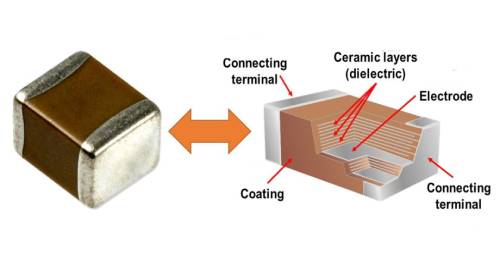
Advantages of Multilayer Ceramic 100nF Capacitor
Multilayer ceramic 100nf capacitor (MLCCs) offer several advantages that make them a popular choice in electronic circuits. Here are some of the key advantages of MLCCs:
- High Capacitance Density: MLCCs provide high capacitance values in a small package size. They offer a high capacitance density, allowing for more capacitance in a limited space on a circuit board. This is particularly beneficial for miniaturized electronic devices and space-constrained applications.
- Wide Range of Capacitance Values: MLCCs are available in a wide range of capacitance values, from picofarads (pF) to microfarads (uF). This versatility allows designers to select the appropriate capacitor for their specific circuit requirements.
- Low Equivalent Series Resistance (ESR): MLCCs typically have low ESR, which means they offer low resistance to the flow of alternating current (AC). Low ESR is desirable for applications that require fast charge and discharge cycles or high-frequency operation, as it minimizes energy losses and improves circuit efficiency.
- High Voltage Ratings: MLCCs are available with high voltage ratings, allowing them to handle higher voltages in electronic circuits. This makes them suitable for a wide range of applications, including power electronics and high-voltage circuits.
- Excellent Frequency Response: MLCCs exhibit good frequency response characteristics, making them suitable for applications that require stable performance across a broad frequency range. They offer low impedance at high frequencies, allowing them to handle high-speed signals effectively.
- Temperature Stability: MLCCs are available with different temperature coefficients, such as X7R, X5R, and C0G (NP0). The C0G (NP0) MLCCs have a nearly flat temperature coefficient, providing stable capacitance values over a wide temperature range. This temperature stability is crucial for applications that operate in varying temperature conditions.
- High Reliability: MLCCs are known for their high reliability and long operational life. They are resistant to mechanical stress, temperature variations, and aging. MLCCs also have excellent resistance to moisture and humidity, making them suitable for demanding environmental conditions.
- Cost-Effective: MLCCs are cost-effective compared to some other types of capacitors, such as tantalum or electrolytic capacitors. They offer a good balance between performance and cost, making them a preferred choice for many applications.
- RoHS Compliance: MLCCs are typically RoHS compliant, meaning they do not contain hazardous substances like lead, mercury, or cadmium. This compliance with environmental regulations is important for ensuring the safety and sustainability of electronic products.
- Availability and Compatibility: MLCCs are widely available from various manufacturers and distributors, making them easily accessible for design and production needs. They are compatible with standard surface-mount technology (SMT) processes, making them suitable for high-volume manufacturing.
Overall, the advantages of MLCCs make them versatile and widely used in a broad range of applications, including consumer electronics, automotive electronics, telecommunications, industrial equipment, and more.
Specific applications of multilayer ceramic 100nF capacitor
Multilayer ceramic capacitors (MLCCs) are versatile components used in a wide range of electronic applications. Some specific applications of MLCCs include:
- Decoupling and Bypass Capacitors: MLCCs are commonly used as decoupling and bypass capacitors to filter out noise and stabilize power supply lines in electronic circuits. They help to maintain a stable voltage level and improve the performance and reliability of integrated circuits.
- Timing and Oscillation Circuits: MLCCs are utilized in timing and oscillation circuits to control the frequency and timing of signals. They are often found in crystal oscillators, resonators, and timing circuits.
- Filtering and Signal Coupling: MLCCs are used for filtering and signal coupling in various applications such as audio systems, communication devices, and RF circuits. They can attenuate unwanted frequencies and pass desired frequencies, allowing for efficient signal processing.
- Power Electronics: MLCCs are employed in power electronics applications, including voltage regulation, power conversion, and energy storage. They can handle high voltages and provide stable capacitance in harsh operating conditions.
- EMI/RFI Suppression: MLCCs with high-frequency capabilities are used for electromagnetic interference (EMI) and radio frequency interference (RFI) suppression. They help to reduce noise and interference in electronic circuits and systems.
Packaging Type
MLCCs are available in different package types, including surface-mount technology (SMT) packages, such as 0805, 0603, 0402, and others, as well as through-hole packages for certain applications.
0805, 0603, and 0402 are package sizes or dimensions for surface-mount technology (SMT) multilayer ceramic capacitors (MLCCs). These numbers refer to the dimensions of the MLCC package, indicating its length and width in imperial units (mils) or metric units (millimeters). Here’s a brief description of each package size:
- 0805: An 0805 MLCC package measures approximately 0.08 inches (2.0 mm) in length and 0.05 inches (1.25 mm) in width. This package size is commonly used for a wide range of applications due to its popularity and availability.
- 0603: A 0603 MLCC package measures approximately 0.06 inches (1.6 mm) in length and 0.03 inches (0.8 mm) in width. It is smaller than the 0805 package, making it suitable for compact circuit designs where space is limited.
- 0402: An 0402 MLCC package measures approximately 0.04 inches (1.0 mm) in length and 0.02 inches (0.5 mm) in width. It is the smallest package size among these three options and is commonly used in ultra-compact electronic devices and miniaturized circuit boards.
It’s important to note that as the package size decreases, the capacitance value of the MLCC may be lower due to space limitations. However, advancements in MLCC technology have allowed for higher capacitance values even in smaller package sizes.
Conclusion
Multilayer ceramic 100nF capacitor are essential components in modern electronic circuits due to their numerous advantages. They offer high capacitance density, allowing for more capacitance in a compact package size. MLCCs are available in a wide range of capacitance values and voltage ratings, making them suitable for various circuit requirements. They exhibit low equivalent series resistance (ESR) and excellent frequency response, enabling efficient charge and discharge cycles and stable performance across a broad frequency range.
MLCCs also provide temperature stability, ensuring consistent capacitance values over a wide temperature range. They are highly reliable, resistant to mechanical stress, temperature variations, and aging. MLCCs are cost-effective compared to alternative capacitor types and are readily available from different manufacturers, making them compatible with standard surface-mount technology (SMT) processes.
Overall, the advantages of MLCCs make them a preferred choice for applications in consumer electronics, automotive electronics, telecommunications, industrial equipment, and more. Their high performance, compact size, reliability, and cost-effectiveness contribute to their widespread use in electronic devices, enabling the development of smaller, more efficient, and reliable products.

